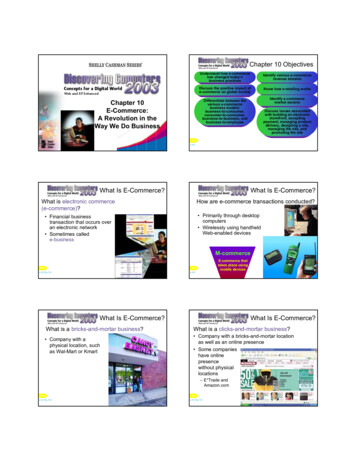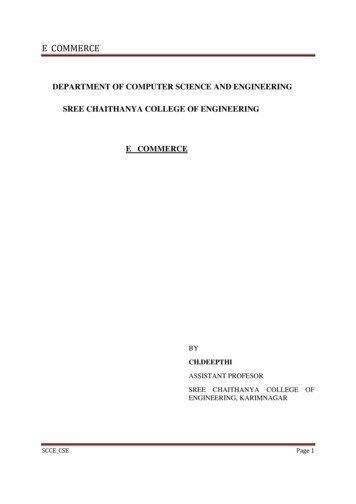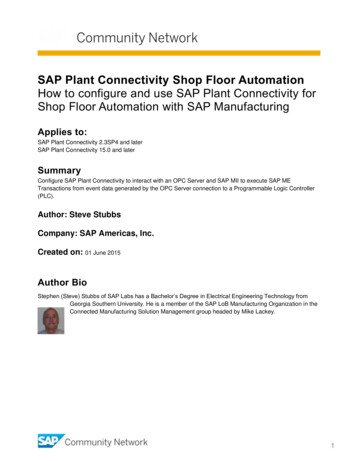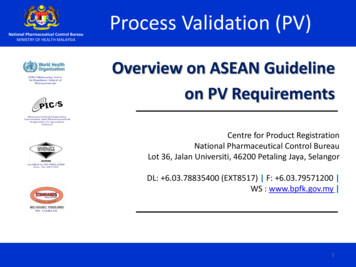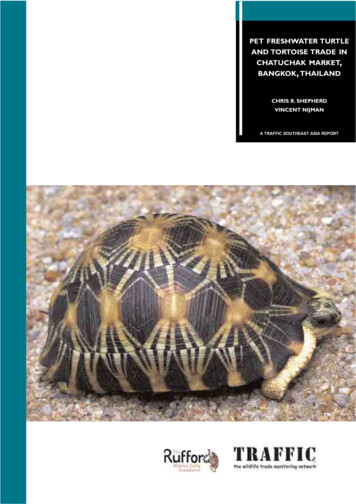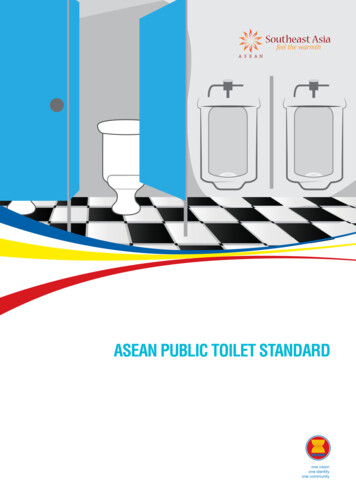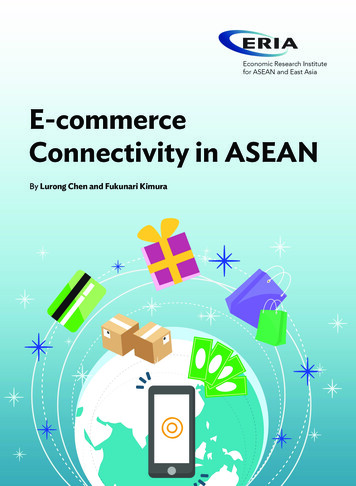
Transcription
E-commerceConnectivity in ASEANEdited by Lurong Chen and Fukunari Kimura
E-commerce Connectivity in ASEANPublished byEconomic Research Institute for ASEAN and East Asia (ERIA)Sentral Senayan 2, 6th floorJalan Asia Afrika No. 8Central Jakarta 10270Indonesia Economic Research Institute for ASEAN and East Asia, 2020Published in April 2020.All rights reserved. No part of this publication may be reproduced, stored in a retrieval system, ortransmitted in any form by any means electronic or mechanical without prior written notice to andpermission from ERIA.The findings, interpretations, and conclusions expressed do not necessarily reflect the views and policiesof the Economic Research Institute for ASEAN and East Asia, its Governing Board, Academic AdvisoryCouncil, or the institutions and governments they represent.Material in this publication may be freely quoted or reprinted with proper acknowledgement.Cover Art by ArtmosphereBook Design by Ranti AmeliaNational Library of Indonesia Cataloguing-in-Publication DataISBN: 978-602-5460-24-1
ContentsList of Figures xList of Tables xivAcknowledgements xviiList of Contributors xviiiChapter 1Overview 1Lurong Chen and Fukunari KimuraChapter 2Improving Digital Connectivity for E-commerce: A Policy Framework and Empirical Note7Lurong Chen1 Introduction 72 Data Connectivity 103 Logistics 184 Financial Connectivity 215 Integrating Connectivity 236 Policy Suggestions 26References 28iii
Chapter 3Indonesia on the Move: Improving Connectivity to Support E-commerce31Kalamullah Ramli1 Introduction 312 National Vision and General Policy Environment for Development 323 ICT Connectivity 334 Free Flow of Goods 365 Regulation to Support E-commerce 426 Policy Recommendations 467 Conclusion 48References 49Chapter 4Improving Logistics Connectivity of E-commerce in the ASEAN Region51Arkadiusz Kawa1 Introduction 512 The Importance of Logistics to ASEAN 533 Logistics Support for E-commerce 554 Logistics Connectivity 565 Impediments to and Inequalities in Logistics Connectivity 586 Policy Recommendations 657 Conclusion 70References 72iv
Chapter 5Prospects and Challenges in Improving E-commerce Connectivity in Malaysia78Noor Azina Ismail and Muhammad Mehedi Masud1 Introduction 782 E-commerce Connectivity in Malaysia 793 E-commerce Potential 904 Challenges of E-commerce 915 Digital Free Trade Zone 926 Discussion and Conclusion 94References 96Chapter 6How Can E-marketplaces Turn Thailand into a Distributive Economy?99Nuttawut Laksanapanyakul1 Introduction 2 Income Inequality Issues 991003 Assessing E-marketplaces in Thailand 1024 Key Success Factors for and Obstacles Against the Development 113and Operation of Pro-equality E-marketplaces5 Conclusion and Policy Recommendations 117References 118v
ContentsChapter 7Policy Environment for E-commerce Connectivity in Viet Nam120Dang Thi Phuong Hoa and Lurong Chen1 Background 1202 Literature Review 1223 Data 1234 E-commerce Connectivity in Viet Nam 1245 Policy Suggestions 1366 Conclusion 139References 140Chapter 8Enabling India's E-commerce Connectivity with ASEAN: E-payment in India - Problems and Prospects146Sanjay Kumar Mangla, Sanjaya Kumar Lenka, and Rohit Singh1 Introduction 1462 E-commerce Connectivity in India 1473 E-payment: National Priority 1504 E-payment and E-commerce: Convergence 1575 E-payment and E-commerce: Challenges 1646 India-ASEAN Digital Payment Connectivity 1667 Conclusion and Policy Recommendations 168References 170vi
Chapter 9A Threshold for Tariff and/or Tax Exemption 173Inkyo Cheong1 Introduction 1732 E-commerce in ASEAN 1753 A Threshold for Tariff/Tax Exemption 1774 Logic for the Customs De Minimis 1825 E-commerce and Trade Facilitation in FTAs 1856 Conclusion 191References 192Chapter 10Network Cooperation in Cross-border E-commerce: A Conceptual Model of a Logistics Platform195Arkadiusz Kawa1 Introduction 1952 E-commerce Logistics 1963 Cross-border E-commerce 1994 Challenges of Cross-border E-commerce 2015 Logistics of Cross-border E-commerce 2036 System of Distribution in Cross-border E-commerce in the ASEAN Region 2057 Logistics Platform Proposal 2108 Summary 214References 215vii
Chapter 11Reconfiguring Production and Logistics Networks under the Global E-commerce Environment218Jin Young Hong and Ha Neul Han1 Background 2182 Postal Electronic Services and Cross-border E-commerce 2203 Competitive Neutrality Frameworks 2254 Enhancing Connectivity Strategies of Post Offices in Cross-border E-commerce 2285 Conclusion 232References 234Chapter 12E-commerce Development in the Lao PDR: Some Policy Concerns235Leeber Leebouapao, Phonesavanh Sitthideth,Keokhuanchay Douangpaseuth, and Yuanita Suhud1 Introduction 2352 Review of E-commerce Development and Lessons Learnt 2363 E-commerce Development in the Lao PDR 2384 Conclusion 248References 249viii
Chapter 13An Integrated E-commerce Platform for the ASEAN Tourism Industry: A Smart Tourism Model Approach252Meghdad Abbasian Fereidouni and Hossein Nezakati Alizadeh1 Introduction 2522 Literature Review and Statistical Background 2543 Conceptualising a Smart Tourism Destination Platform Model 2634 Methodology 2685 Findings 2706 Concluding Remarks 272References 273Chapter 14Connectivity and the Healthcare Market in Myanmar 281John Walsh1 Introduction 2812 Healthcare in Myanmar 2833 Mobile Telephones in Myanmar 2864 Research Methods 2885 Findings 2916 Discussion 3017 Conclusion 302References 303ix
List of FiguresFigure 2.1: The Growth of E-commerce Revenue and GDP8Figure 2.2: Country Share in the Regional Market8Figure 2.3: A Framework of Digital Connectivity9Figure 2.4: Affordability of Mobile Connection, 2014 vs. 201813Figure 2.5: Relative Price of Smartphone and Mobile Data14Figure 2.6: E-participation16Figure 2.7: Logistics Performance20Figure 2.8: The Share of Adults Without a Formal account22(as % of all adults age 15 )Figure 2.9: E-payment Transaction Value and Penetration22Figure 3.1: Palapa Ring Project Deployment in 201836Figure 3.2: A Model of Logistics Chain in Indonesia39Figure 3.3: Indonesia's National Connectivity Framework40Figure 3.4: Eight Key Interrelated Areas of Indonesia’s E-commerce43RoadmapFigure 3.5: Hierarchy, Scope of Content, and Flexibility47of Indonesia LegislationFigure 4.1: A Framework of ASEAN Logistics System55Figure 4.2: Logistics Performance Index Ranking in ASEAN Countries,602007–2018Figure 5.1: E-payment and E-banking in Malaysiax87
Figure 6.1: Thailand’s Income Distribution by Decile, 2015Figure 6.2: Sales Price and Distribution of Gross ProfitsAlong the Shrimp Value Chain in Thailand101102Figure 6.3: Structure-Conduct-Performance (SCP) Framework103Figure 6.4: E-commerce Traded in Thailand, 2014–2016104Figure 6.5: E-commerce Customers in Thailand, 2014–2016105Figure 6.6: Ratio of Sector-wise SME E-commerce bySales Channel in Thailand, 2016Figure 6.7: Sector-wise SME E-commerce traded bySales Channel in Thailand, 2016Figure 6.8: Sales of Large and of Small and Medium-sizedE-enterprises in Thailand, 2014–2016Figure 6.9: Sector-wise Large and Small and Mediumsized E-enterprises in Thailand, 2016105106110111Figure 7.1: Four Levels of E-government Service in Viet Nam133Figure 7.2: Legal Framework to Support E-commerce138Figure 8.1: Growth of E-commerce in India,Value of Digital148Commerce in India (INR billion)Figure 8.2: E-payment Gateways available on IRCTC158Figure 8.3: E-payment Wallet Options available on IRCTC158Figure 8.4: Credit and Debit Card E-payment Options available on IRCTC160Figure 10.1: Hub and Spoke System198Figure 10.2: Hub and Spoke System in Distribution Within a Single Country199Figure 10.3: Cross-border E-commerce Challenges201Figure 10.4: Hub and Spoke System in Distribution Between Two Countries203Figure 10.5: Hub and Spoke System in Distribution Between Two204Countries With Two Customers and Two Online Shopsxi
Figure 10.6: Information About the Origin, Destination,206Dimensions, and Weight of ShipmentFigure 10.7: Delivery Options to be Chosen by Customers206Figure 10.8: Parameters of Domestic Shipment from Yogyakarta to Medan208Figure 10.9: Rates of Domestic Shipment from Yogyakarta to Medan209Figure 10.10: Parameters of Domestic Shipment from209Kuala Lumpur to Sungai PetaniFigure 10.11: Rates of Domestic Shipment from Kuala210Lumpur to Sungai PetaniFigure 10.12: Cross-border E-commerce with a Logistics Platform213Figure 11.1: Post Office Staff in ASEAN222Figure 11.2: Percentage of Delivery Staff (%)223Figure 11.3: Number of Express Items and Parcels for224International Service Dispatch, 2016Figure 11.4: Number of Sorting Centres225Figure 11.5: Competitive Convergence Patterns in Cross-226border E-commerce LogisticsFigure 11.6: Identified Delivery Models of Drones and229Autonomous Ground VehiclesFigure 11.7: Malaysia's E-commerce Logistics Hub232Figure 12.1: Credit Card Users244Figure 13.1: Global Internet Penetration Comparison256Figure 13.2: Mobile Connectivity Index Score257Figure 13.3: Global Internet Speed (Mbps)259Figure 13.4: Share of Unbanked Adults Aged Above 25 (%)259Figure 13.5: ASEAN Country Respondents’ Reasons261to not Make a Cross-border Purchasexii
Figure 13.6: ASEAN Countries: Online Sources Used262to Make a Purchase DecisionFigure 13.7: Tourism Ecosystem: Main Components264Figure 13.8: Human System or Tourism Stakeholders265Figure 13.9: Smart Tourism Destination Platform268(STDP) Graphical FrameworkFigure 14.1: Healthcare System in Myanmar284xiii
List of TablesxivTable 2.1: ASEAN Access to the Internet11Table 2.2: Speed of Fixed-line and Mobile Connection12Table 2.3: Content of the Internet, Qualitative Rating and Score15Table 2.4: Cybersecurity: Preparedness and Commitments18Table 2.5: Quality of Logistics Infrastructure19Table 2.6: E-payment Readiness23Table 2.7: National ICT Authority and Plan24Table 4.1: Three Components of Logistics Connectivity57Table 4.2: Logistics Performance Index Ranking and ItsComponents of ASEAN Countries, 201861Table 4.3: Logistics Connectivity in ASEAN Countries– Problems and Actions61Table 4.4: Main Impediments to Logistics Connectivity in ASEAN63Table 4.5: Measures and Actions Related to Policy Recommendations71Table 5.1: E-commerce Initiatives by Ministries and Agencies in Malaysia80Table 5.2: State of Internet Connectivity for Selected Asia-PacificCountries, First Quarter, 201784Table 5.3: Logistics Performance Index, Malaysia, 201685Table 5.4: Comparing Internet Prices in Malaysia88Table 6.1: Examples of E-marketplace Operators in Thailand106Table 7.1: Decrees in Regulating E-commerce Transactions126Table 7.2: Decrees in Regulating E-commerce Behaviours126Table 7.3: Distribution of Logistics Enterprises by Province, 2017(% total logistics enterprises)129
Table 7.4: Progress of E-government in Viet Nam134Table 7.5: Assessment of Public Services (%)134Table 7.6: Implementation of Specific E-government Tasks ofMinistries, Branches, and Local Governments135Table 8.1: Trends in Volume and Value of Selected E-paymentSystems, 2013–2014 to 2016–2017160Table 8.2: Trends in Volume and Value of Selected E-PaymentSystems after Demonetisation in November 2016161Table 8.3: Trends in Volume and Value of Payments through Walletsand Mobile Banking, from 2013–2014 to 2016–2017163Table 9.1: ASEAN countries’ B2C E-commerce Index 2016175Table 9.2: The Progress of Tariff Liberalisation in ASEAN 1 FTAs178Table 9.3: Distribution of Shipments of Major Blocs (2015)183Table 9.4: Costs and Benefits of Raising de minimis Threshold to US 800184Table 9.5: Online Retail Sales (% of Total Retail Sales)186Table 9.6: Comparison of Express Shipments189Table 10.1: Rates of Shipment Between the ASEAN Members States (US )207Table 11.1: Universal Postal Union Definitions of E-commerce Services221Table 11.2.: Development of Postal E-Commerce in ASEAN221Table 11.3: Average Coverage Area per Post Office222Table 11.4: Types of E-commerce Business Models by Relationship227Table 11.5: Logistics Demand by Relationship227Table 11.6: Comparison of E-commerce Logistics Hubs230Table 12.1: Stages of E-government Action Plan240Table 12.2: E-government Action Plan Targets241xv
Table 12.3: IT Development Ranking in Selected Countries in Asia242Table 12.4: Internet Access in Lao PDR, 2017243Table 13.1: ASEAN Economy and Internet Penetration255Table 13.2: Mobile Connectivity Indicators258Table 13.3: Website and Social Media Accessibility260Table 13.4: Evaluation Linguistic Term Set and Its269Corresponding Triangular Fuzzy NumbersTable 13.5: Final Weights of Evaluation Indicators271Using Fuzzy Delphi MethodTable 13.6: Overview of Final Weight Evaluation Result272Table 14.1: Public Health Facilities in Myanmar, 2014284Table 14.2: Location of Respondents293Table 14.3: Occupations of Respondents294Table 14.4: Frequency of Use of Facebook and the Internet295and Length of Ownership of AccessxviTable 14.5: Searching for Health Information with Mobile Telephones295Table 14.6: Analysis of Information Sources for Health Information296Table 14.7: Satisfaction with Health Services Received298Table 14.8: Analysis of Satisfaction with Health Services Received298Table 14.9: Comments about Improving Healthcare Services299
AcknowledgementsA key part of ERIA's serial project on ‘Digital Economy, Innovation and Asia'sCompetitiveness in Global Value Chains (GVCs)’, this editorial volume,E-Commerce Connectivity in ASEAN, brings together 14 chapters that collectivelyprovide a major statement on how ASEAN can improve digital connectivity tofacilitate e-commerce development and digital transformation.Strong encouragement and invaluable advice from Professor Hidetoshi Nishimura,the President of ERIA, has been critical for the completion of this project.Various forms of support from our colleagues, in particular Hank Lim, Shujiro Urata,Koji Hachiyama, Taizo Hara, Izuru Kobayashi, Shigeki Kamiyama, Stefan Wesiak,Fadriani Trianingsih, Chrestella Budyanto, Rachmadea Aisyah, Lydia Ruddy, andTyagita Silka Hapsari, is gratefully acknowledged.Yuanita Suhud and Meilawati provided excellent research assistance throughout thecompilation of the book.Last but not least, we are indebted to all the contributors to this book. Theirenthusiasm has been unwavering, from their involvement in the initial researchprojects and throughout the subsequent dialogues to complete this book.Lurong Chen and Fukunari Kimuraxvii
List of ContributorsArkadiusz Kawa is a Director at the Lukasiewicz Research Network - Instituteof Logistics and Warehousing, Poland. He received his PhD and habilitation ineconomics from the Poznań University of Economics and Business.Dang Thi Phuong Hoa is Associate Professor and Senior Research Fellow at theVietnam Academy of Social Sciences (VASS), Viet Nam. She received her PhD inregional economics from the Graduate Academy of Social Sciences, Viet Nam.Fukunari Kimura is Chief Economist at the Economic Research Institute for ASEANand East Asia (ERIA) and a Professor at the Faculty of Economics, Keio University,Japan. He obtained his PhD in economics from the University of WisconsinMadison, USA.Ha Neul Han is a Researcher at the Jungseok Research Institute of InternationalLogistics and Trade (JRI), Department of International Trade, Inha University,Korea. He received his PhD from the Economics Graduate School of InhaUniversity, Republic of Korea.Hossein Nezakati Alizadeh is an Associate Professor in Marketing at SunwayUniversity Business School, Malaysia. He received his PhD in business managementfrom Islamic Azad University (IAU), Iran.Inkyo Cheong is a Professor of International Trade at the Inha University, Incheon,Republic of Korea. He also serves as Director of the FTA Research Forum.Jin Young Hong is a Researcher at the Jungseok Research Institute of InternationalLogistics and Trade (JRI), Department of International Trade, Inha University,Korea. He received his PhD in economics from the Economics Graduate School ofInha University, Korea.John Walsh is a Lecturer in International Business at the Hanoi Campus of RMITViet Nam. He received his doctorate from Oxford University, UK.xviii
Kalamullah Ramli is a Professor and Chairman at the Center for Science and TechnologyResearch (CSTR), Universitas Indonesia. He received his doctoral degree fromUniversitaet Duisburg-Essen, NRW, Germany.Keokhuanchay Douangpaseuth is a Technical Officer at the Center for EnterpriseDevelopment Policy and International Integration Research, National Institute forEconomic Research (NIER), Lao PDR. He received his master's degree in internationalrelations from the Graduate School of International Relations, Ritsumeikan University,Kyoto, Japan.Leeber Leebouapao is Vice President (Deputy Minister) of the National Institute forEconomic Research (NIER) and a member of the Lao National Assembly, Lao PDR.Lurong Chen is a Senior Economist at the Economic Research Institute for ASEAN andEast Asia (ERIA), Indonesia. He obtained his PhD in international economics from theGraduate Institute in Geneva, Switzerland.Meghdad Abbasian Fereidouni is a PhD candidate in Management from LimkokwingUniversity, Malaysia.Muhammad Mehedi Masud is a Senior Lecturer at the Faculty of Economics andAdministration, University of Malaya. He received his PhD from University of Malaya.Noor Azina Ismail is a Professor at the Faculty of Economics and Administration,University of Malaya. She received her PhD from Queensland University of Technology,Australia.Nuttawut Laksanapanyakul is a consultant at the Thailand Development ResearchInstitute (TDRI), Thailand. He received a master's degree in chemical engineering fromChulalongkorn University, Thailand.Phonesavanh Sittideth is a researcher at the Center for Enterprise Development Policyand International Integration Research, National Institute for Economic Research(NIER), Lao PDR. She received her master's degree in International Development fromFlinders University, Australia.xix
Rohit Singh is a former policy analyst with CUTS International, Jaipur, India. He is acomputer science engineer from Rajasthan University, India and has a post graduatediploma in forestry management from the Indian Institute of Forest Management, India.Sanjay Kumar Mangla is an Associate Professor in Economics at Maharaja AgrasenInstitute of Management Studies (an affiliated college of Guru Gobind SinghIndraprastha University), New Delhi, India. He received his PhD in economics fromJamia Millia Islamia University, Delhi, India.Sanjaya Kumar Lenka is an Assistant Professor in Economics at DIT University,Dehradun, India. He received his PhD in economics from IIT Indore, India.Yuanita Suhud is a Research Associate at the Economic Research Institute for ASEANand East Asia (ERIA). She holds a master's degree from the Australian NationalUniversity, Australia.xx
ChapterOverview1Lurong ChenFukunari Kimura1. IntroductionElectronic commerce (e-commerce) has been radically altering our society. Economicactivities using tools of the Internet or new information and communications technology(ICT) to purchase goods or services or conduct business online are rapidly expanding. Globalcross-border e-commerce has become increasingly important in the international economy.Various factors have laid a solid foundation for the booming cross-border e-commerce,such as high-speed Internet, the use of smartphones, the facilitation of online payments,the changes in consumer behaviour, services sector liberalisation, and so on. Global retaile-commerce sales have been growing faster than traditional retail sales since 2014.Asia is benefiting more than any other region in the world when cross-border e-commercehas introduced new dynamics to international trade (Chen, 2017). The next Asian miracleof growth could be born with the region's digital transformation to the new era, whose newideas, new technologies, new mindset, new tools, and new businesses are changing the wayof people's living, work, and study. E-commerce is disruptive to the traditional wholesalingand retailing not only by bringing business from offline to online but, more importantly, byintroducing new digital tools, such as artificial intelligence, cloud computing, big data, andmachine learning, into the business. To the end users, the most obvious distinction betweene-commerce and the traditional business mode is that e-commerce activities involve fewerintermediate links between sellers and buyers. It has higher requirements on services,especially those on information, payments, and logistics. The digital platform can also pool allthe related services for market matching.The Association of Southeast Asian Nations (ASEAN) member states Singapore, Malaysia,and Indonesia have been amongst the world’s top markets with the highest online shoppingpenetration rate. In the next 5 years, an increasing share of private consumption incrementswill come from global e-commerce growth.1
E-commerce Connectivity in ASEANThe sustained growth of online shoppers provides the solid base of e-commerceconsumption. Overall, the scale of digital economy in ASEAN is projected to increase by 5.5times by 2025 (Think with Google, 2016).Digital connectivity is the cornerstone that will make the changes feasible and smoothen thetransformation. This book aims to provide related insights from the regional perspective. It iscomposed of 14 chapters (including this introductory chapter) that discuss the improvementof regional connectivity for digitalisation from various aspects and combined deliver a positivemessage on the region's progress in digital transformation.2. Structure and Chapter SynopsesChapter 2 by Lurong Chen, ‘Improving Digital Connectivity for E-commerce: A PolicyFramework and Empirical Note’, proposes a policy framework of promoting digitalconnectivity to support the development of e-commerce. Using this analytical frameworkfor ASEAN economies, the chapter suggests that to narrow the development gaps in ICTrelated infrastructure, either cross-border or within a country, there is a need for policy effortto improve (i) data connectivity from the aspects of network coverage, speed of Internetconnection, affordability, online content, and cybersecurity; (ii) logistics for the free flow ofgoods and services; (iii) connectivity to facilitate cash flows; and (iv) seamless links betweenthe cyberspace and the physical parts of the e-commerce network.Improving institutional connectivity and service development play a significant role in all theseaspects. Looking forward, digital connectivity is essential for the digital-friendly ecosystemthat will facilitate digital transformation in the region, which will affect not only e-commercebut also the nation's overall economic performance.Chapter 3 by Kalamullah Ramli, ‘Indonesia on the Move: Improving Connectivity to SupportE-commerce’, is an overview of Indonesia's national vision and general policy environment inpreparing to be ‘the digital energy of Asia’. It highlights the challenges faced by Indonesia indeveloping its digital economy and analyses the government’s efforts to solve these problems.Ramli's discussion focuses on three aspects: ICT connectivity, trade facilitation, ande-commerce regulations. He suggests that the government establish and complete an agileand flexible regulatory framework to support the digital economy in Indonesia by limiting thescope of law to basic principles at higher-level legislation but leaving more detailed technical2
Overviewrule setting to lower-level legislation. Given the diversity across Indonesia's different regions,it would be helpful if the central government could allow governments at different levelssome more flexibility in ‘exercise[ing] constitutionally assigned legislative and executiveresponsibilities’ to find solutions to meet the local needs to improve connectivity.Arkadiusz Kawa in Chapter 4, ‘Improving Logistics Connectivity of E-commerce in theASEAN Region’, highlights the importance of logistic connectivity and points out thatcapacity and performance significantly vary in ASEAN. It is not rare to see poor infrastructurelimiting logistics efficiency and, therefore, a country's competitiveness. Kawa's study suggeststhat, in addition to further enhancing air, land, and maritime connectivity, ASEAN needsmore interoperability to facilitate data flow and exchange. In particular, it is important toimprove the efficiency of e-commerce logistics services to consolidate and further developsupply chains. At the micro level, competing companies should be encouraged to createpartnerships enabling the exchange of knowledge and experience and sharing of resources tocarry out specific tasks.Chapter 5, ‘Prospects and Challenges in Improving E-commerce Connectivity in Malaysia’,prepared by Noor Azina Ismail and Muhammad Mehedi Masud, assesses the readiness ofMalaysian small and medium-sized enterprises to participate in e-commerce based on thefour aspects of connectivity that Chen (2017) proposed. Malaysia evidently has a largepotential in developing e-commerce, and the country has made substantial progress inimproving connectivity.Ismail and Masud point out that Malaysia’s largest challenge is the rather weak linkbetween the physical and virtual parts of e-commerce network. Another problem is theuneven development across urban and rural areas, especially in aspects such as e-banking,e-fulfilment, and consumer protection. The establishment of Digital Free Trade Zone willhelp Malaysia accumulate experience on how to overcome challenges and strengthen itscompetitiveness in the digital economy through regional or subregional cooperation.In Chapter 6, ‘How Can E-marketplaces Turn Thailand into a Distributive Economy?’,Nuttawut Laksanapanyakul emphasises the market mechanism and explores the waysto unleash the potential of e-marketplace development and transform Thailand into adistributive economy, with emphasis on income inequality issues. It analyses the structureand performance of online marketplaces in Thailand, in an attempt to assess whether thedevelopment of e-commerce could help narrow the country’s income inequality.3
E-commerce Connectivity in ASEANThe study shows that although digitalisation could help reduce income inequality, inThailand, most of such ‘pro-equality’ effects seem to be cancelled out by factors such asuneven access to the Internet, lack of trust of online business, and the backlog of the legalsystem. To overcome these obstacles, it needs joint effort by the government and the privatesector.Chapter 7, ‘Policy Environment for E-commerce Connectivity in Viet Nam’, uses Chen’s(2017) framework of digital connectivity to evaluate the progress of economic digitalisationin Viet Nam, with particular emphasis on the country's e-commerce–related regulatorysystem. For each layer, Dang Thi Phuong Hoa and Lurong Chen analyse both Viet Nam'sachievements and the still-existing challenges in connectivity.Experience in Viet Nam shows that the uneven paces of digitalisation across cities andprovinces could also be due to differences in the local governments' implementation of policyset by the central government. As for the solution, a critical step is to switch the mindset ofthe administration in policymaking from state centred (supporting the business in the waythat the state wants) to market centred (supporting those that the market asks for).Sanjay Kumar Mangla, Sanjaya Kumar Lenka, and Rohit Singh in Chapter 8, ‘Enabling India’sE-commerce Connectivity with ASEAN: E-payment in India – Problems and Prospects’,investigate the status quo of e-commerce–related connectivity in India as well as thatbetween India and ASEAN, specifically in the aspect of ICT and logistics. It further providesinsights on India's development of online payments.Making India a cashless society is a government priority. But at this stage, e-paymentpenetration is still low, especially in rural areas and amongst small businesses. Therefore, it isnecessary to have a continuous effort on improving ICT and logistics infrastructure, inducingtransparency of regulation, and establishing an e-commerce–friendly environment withthoughtful consideration on related issues such as cybersecurity and data privacy, financialinclusion, online dispute resolution, and digital literacy.In Chapter 9, ‘A Threshold for Tariff and/or Tax Exemption’, Inkyo Cheong points out that thelack of information and the burden of a tariff are amongst the typical impediments of crossborder e-commerce for ASEAN member states. Cross-border e-commerce is evidently notonly limited by physical infrastructure but is also under the restrictions of tariff exemption.The regime of ‘express shipments’ applied by the Korea–United States Free Trade Agreement(FTA) has turned out to be effective in facilitating the shipments of low-value trade goods4
Overview(value less than US 200). That four-fifths of world online-traded goods are with a valuelower than US 200, including the provision of de minimis for duty-free shipments in a regionwide free trade agreement, such as the Regional Comprehensive Economic Partnership(RCEP), could be a good way to introduce such a regime in regional trade in Asia and promotethe development of e-commerce, especially that of cross-border e-commerce.Chapter 10 by Arkadiusz Kawa, ‘Network Cooperation in Cross-border E-commerce: AConceptual Model of a Logistics Platform’, highlights the problem existing in cross-borderdeliveries and demonstrates how this could be an obstacle to the development of onlinebusiness. The chapter further develops a conceptual model of a logistics platform to integratethe whole logistics chain and increase the efficiency of the network of cross-border cargodelivery. The model requires increasing interoperability amongst all participating parties. Itis recommended that policymakers in ASEAN work together to push forward the process ofregulations harmonisation, promote non-cash transactions, improve logistics i
5 Digital Free Trade Zone 92 6 Discussion and Conclusion 94 References 96 Chapter 6 How Can E-marketplaces Turn Thailand 99 into a Distributive Economy? Nuttawut Laksanapanyakul 1 Introduction 99 2 Income Inequality Issues 100 3 Assessing E-marketplaces in Thailand 102 4 Key Succ


